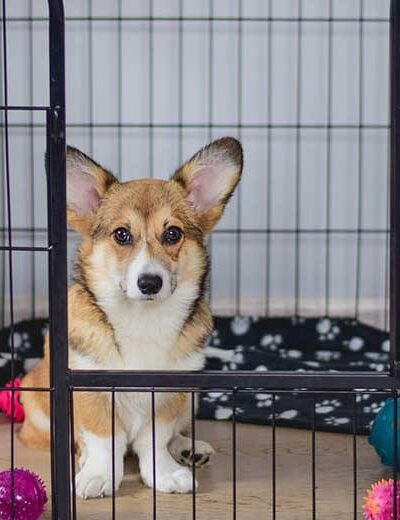If you have recently welcomed a new dog to your home or are about to, you’ll want to provide a safe, comfortable space for them where they can relax. One way to provide this is through having their own crate, giving them their own personal space to sit and sleep in.
For this to be effective, however, you’ll need to train your dog to use a crate, especially if this is new to them. If you are unsure whether it is worth doing or what the benefits are, below you will find a few tips on how to crate train and how it can be beneficial for their overall well-being.
What is Crate Training and How Does it Help My Dog?
Having a dedicated space within the home for your pet is important. Not only will it help them feel part of the family and safe, but it also means they have somewhere to go where they can feel comfortable and either sit or nap. Most owners will have a dog bed or similar for them to relax, but having a crate has its benefits:
- Safety & Comfort– a crate is an enclosed space your dog can feel comfortable in, away from distractions to help them sleep or just spend some downtime by themselves.
- Good for Travel – having a crate can make travel much easier with your dog, whether visiting the vet or going on holiday. It means their safe space is always with them to feel relaxed in.
- Anxiety Reduction– With a new dog, they may understandably feel nervous in new environments or around new people. Having a crate gives them somewhere safe to be and make them feel less anxious.
- House Training– Once your dog associates their crate as somewhere to be comfortable, this can help when looking to toilet train them. They’ll learn eventually to not do this in the crate and go outside, especially with a puppy. You may want to use toilet training pads in the crate to begin with.
- When Left Alone – If you are out of the house for long periods, having a crate trained dog means they will have somewhere to feel safe whilst you are gone, helping to feel less anxious if they don’t like being left alone. It can also help keep them in one place so that they avoid any hazards in the home whilst unsupervised.
For these benefits to work, it requires some training so that your dog builds a positive association with the crate. Simply putting a crate in a room and expecting your dog to use it is unlikely to help, especially if this is new to them. Even if you have adopted a dog that has previously been crate trained, they’ll need to get used to the new environment. Fortunately, the process of training isn’t too difficult and can be a fun way to bond with your new dog.
Is Crate Training Safe For My Dog?
There can be misconceptions about using a crate for your dog, but when trained effectively and the appropriate guidance is followed, there is no reason for your dog to not feel safe or relaxed. Some crates may appear to be just like a cage, but they are not designed to be used for locking your dog away for long periods or being somewhere to go when being punished – crates should only be used as a positive part of their experience.
This is where training them properly and using positive reinforcement can ensure there are no negative associations, becoming part of their home routine when needing somewhere to go and relax. If you have adopted an older dog that has had a previous negative experience with a crate, it can be more challenging, so training them may take longer. Again, it’s all about building a positive association for them.
If crate training your dog does become a struggle, you may want to speak to your vet or an animal behaviourist for advice. If you have insurance, check if the policy covers the cost of alternative treatments that may help. There are pet insurance policies that include coverage for behavioural treatment, so this can be beneficial when looking to help support your dog’s overall well-being.
How to Crate Train Effectively
Depending on where you got your dog from, some breeders may have already helped your dog or puppy get used to being in a crate. Similarly, if you have rehomed from a shelter, your dog may be used to having their own private space within a containment area like a pen or crate. If they haven’t, don’t worry, as they will still need to be trained for a new crate in a new environment and also get used to being with you as their new owner.
Here are some of the things you’ll need to do first to make training simple:
- Perimeter or playpen– With a puppy, you may want to create an area for them where their crate is placed including a perimeter or playpen. This is so they have a safe space to explore whilst being restricted on where they can go.
- Size of the crate– When choosing a crate, it’s important to get the right size for your dog. It shouldn’t be cramped, so ideally needs to be big enough for them to stand up fully without ducking their head, and also be spacious enough for them to lie down and sleep.
- Make it cosy– The crate needs to be appealing for your dog to use. Make sure you have enough comfy bedding and blankets inside and also have enough space for things like toys, as well as their food and water bowl. You’ll also want to consider a blanket that goes over the top of the crate and leaves the front open – this will help to make the inside cosier.
- Good location – Ideally the crate will need to be away from direct sunlight somewhere quiet, as well as not be in a high traffic location with disruptions. It should be somewhere they can still easily see people and what’s going on around them.
Once you have this setup, you can then begin introducing your pup or dog to the crate. Here’s how you can encourage them to use it so they can eventually do so independently:
- Keep the door open– the crate needs to be an open, inviting space, so be sure the door is already open before your pup sees it. With things like toys, their bedding and some food, they will hopefully follow their nose and wander in to investigate. Let them do this in their own time to begin with so they can come and go as they please.
- Use positive reinforcement– you’ll want to make a fuss of them when you do use the crate, so having some appropriate treats will help reward them. They’ll soon make the link with going inside as a positive thing to do. They will hopefully continue to explore the crate and come and go, so continue using food to help. You can also use chews or toys too so that once inside and sitting or lying down, they will spend more time doing so.
- Gradually build up– it will take a few days or so for this behaviour to stick, and the idea is to gradually encourage them to spend longer in the crate so that it becomes more normal and familiar. Every dog is different so having patience and being consistent will help.
Once they seem comfortable with the crate, you can then start to introduce closing the crate door. This is important so that when it comes to leaving them on their own or when transporting them they feel safe and secure.
Like all forms of training your dog, you’ll need plenty of patience and to keep everything a positive experience. Once they get used to a crate by using the tips above, you’ll soon see the difference it makes. Good luck with crate training, and if you need further advice, do speak to your vet as they can assist further.






Leave a Reply